Certain colors can promote healing and enhance your sleep quality through their unique wavelengths and frequencies. You'll get the most restorative sleep by surrounding yourself with soft blues, which mirror nature's calming elements and lower stress levels. Light lavender boosts sleepiness while maintaining serenity, and earth tones like gentle beige create a peaceful backdrop for rest. Green shades can reduce physical discomfort and enhance relaxation. For the best results, avoid bright reds, oranges, and neon colors, which can disrupt your sleep patterns and suppress melatonin production. Understanding how each color affects your body can transform your nightly healing process.
The Science Behind Color Healing

While many people view colors as purely aesthetic elements, they're actually forms of electromagnetic energy that can substantially impact our physical and mental well-being. Each color carries its own unique wavelength and frequency, which can influence your body's physiological responses and emotional state.
Scientific research has begun validating these effects, showing that specific colors can trigger measurable changes in your mood, stress levels, and even sleep patterns. Regular exposure to specific colors has been shown to increase serotonin levels in the body.
Color therapy isn't just an alternative wellness trend – it's gaining recognition from professional medical organizations as a complementary treatment approach. Studies have demonstrated that different colors affect you in distinct ways: blue light helps regulate your circadian rhythms, green promotes relaxation and reduces discomfort, and red stimulates energy levels.
These findings have led to practical applications in clinical settings, including light therapy for seasonal affective disorder (SAD).
When you understand how colors work on a scientific level, you can better harness their therapeutic potential. Your body responds to color exposure whether you're consciously aware of it or not, making it a powerful tool for natural healing and wellness enhancement.
Best Bedroom Colors
Since your bedroom serves as your personal sanctuary for rest, choosing the right colors can substantially impact your sleep quality. Research consistently shows that soft blues and greens create the most soothing environment, as they mirror nature's calming elements like the sky and forest. The use of light lavender tones can effectively boost sleepiness while maintaining a serene atmosphere.
| Color | Effect | Best Used In |
|---|---|---|
| Blue | Promotes tranquility | Walls, bedding |
| Green | Enhances relaxation | Accent pieces |
| Soft Pink | Soothes mind | Decorative items |
You'll want to avoid bright purples and reds, as they can stimulate your mind rather than calm it. Instead, opt for matte finishes in light beige, tan, or soft gray tones to create a peaceful atmosphere. These earth tones provide a neutral backdrop that won't overwhelm your senses as you prepare for sleep.
Consider incorporating your chosen colors through various elements beyond wall paint. You can layer calming shades through bedding, curtains, and decor pieces. Remember that personal preferences matter – while these colors are scientifically proven to aid sleep, your cultural background and individual taste should influence your final choice. Experiment with different combinations of muted shades until you find what works best for your sleep environment.
Colors That Disrupt Sleep
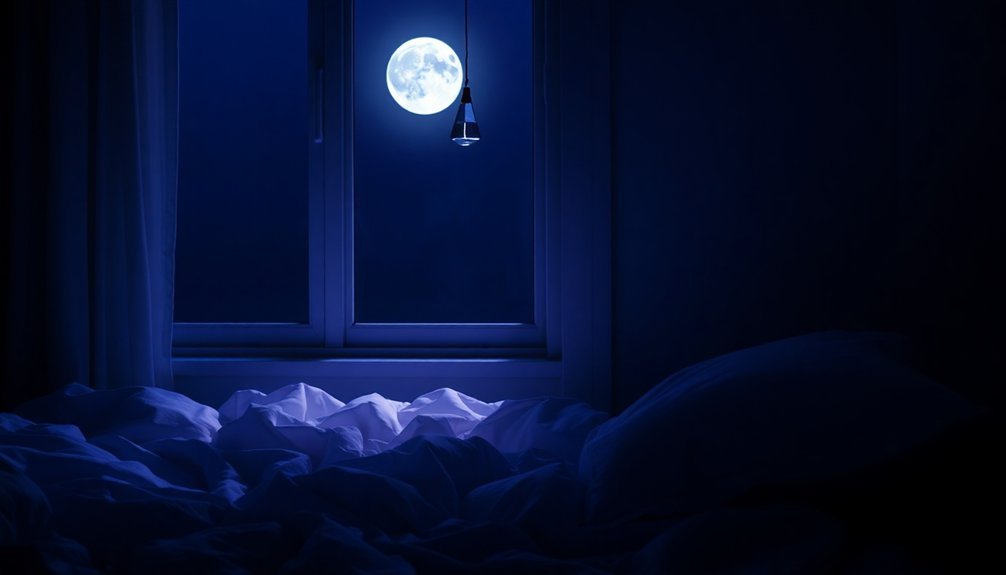
Your bedroom colors can substantially impact your sleep quality, with bright reds and neons being among the worst offenders.
Red tones trigger alertness and can raise your heart rate, making it harder for you to wind down before bedtime.
Bright orange and yellow colors should also be avoided in bedrooms as they are highly stimulating.
Neon colors, which are intensely bright and often contain blue wavelengths, can suppress your body's natural melatonin production and keep you from getting the restful sleep you need.
Bright Reds Delay Rest
Red's commanding presence in a bedroom can significantly disrupt your sleep patterns. When you're exposed to bright red surfaces, your body responds with increased blood pressure and heightened arousal levels, making it harder to drift off to sleep. You'll find that rooms painted in red often feel more stimulating and even smaller than those decorated with cooler hues. Red is directly linked to stress and negative emotions that can interfere with peaceful rest.
While bright red surfaces can interfere with your rest, dim red lighting actually offers surprising benefits. You'll experience better sleep quality with red light therapy, which can boost your melatonin production without disrupting your circadian rhythms.
| Color Impact | Sleep Effect | Recommended Use |
|---|---|---|
| Bright Red Walls | Increases Arousal | Avoid in Bedroom |
| Dim Red Light | Aids Melatonin | Night Light |
| Red Accessories | Moderate Impact | Limited Decor |
| Red Electronics | Sleep Disruptive | Cover/Remove |
| Red Therapy Light | Sleep Supportive | Evening Use |
If you're considering red in your bedroom, opt for muted tones or limit red to small accessories. You'll find better sleep success by combining these softer reds with neutral colors, creating a balanced environment that won't overstimulate your senses before bedtime.
Neons Keep You Alert
Wondering why those trendy neon lights keep you tossing and turning? While neon lights can create a vibrant aesthetic in your space, they're not your best choice for quality sleep.
Cool colors like blue and green, commonly found in neon displays, actively suppress your body's melatonin production and keep you alert when you should be winding down. The brain's hypothalamus receives signals from light-sensitive retinal cells, triggering changes in melatonin release.
You'll find that exposure to these bright artificial lights, especially before bedtime, can substantially disrupt your natural sleep-wake cycle. Your eyes are particularly sensitive to blue and green wavelengths, making these colors the most problematic for sleep. Even white neon lights can overwhelm your system and make it harder to drift off.
If you're determined to keep neon lighting in your bedroom, opt for warmer colors closer to the red spectrum. Red neon lights, when dimmed appropriately, can actually support your body's natural melatonin production. The key is maintaining lower intensity levels – aim for about 10 lux for ideal sleep support.
You might also consider amber-toned neons, as they're less likely to interfere with your circadian rhythm compared to their cooler counterparts.
Natural Light Color Benefits
Your body responds uniquely to different colors in natural light throughout the day, with morning sunlight kickstarting your circadian rhythm and boosting alertness.
As the sun moves across the sky, you'll experience varying light wavelengths that affect your body's internal clock – from energizing blue light during midday to calming red hues at sunset.
These natural color shifts help regulate your sleep-wake cycle, with dawn's bright light signaling it's time to wake up and dusk's warmer tones preparing your body for rest.
Sunlight's Healing Color Spectrum
As sunlight bathes our planet in its radiant glow, it delivers a remarkable spectrum of colors that profoundly influence our physical and mental well-being. You'll find that natural sunlight contains a perfect balance of wavelengths, with 44% in the visible spectrum, providing essential benefits throughout the day.
Your body responds differently to each color wavelength in sunlight's spectrum. Red light enhances your cellular function and ATP production, while blue light helps regulate your sleep-wake cycle. Green light offers a calming effect that reduces your stress levels naturally. Yellow wavelengths ranging from 570 to 585 nanometers show promising potential for maintaining healthy skin.
| Color Wave | Time of Day | Health Benefits |
|---|---|---|
| Red/Orange | Sunrise | Cellular repair, skin health |
| Blue/White | Midday | Energy, alertness |
| Green | Afternoon | Stress reduction, balance |
| Warm Red | Sunset | Relaxation, melatonin production |
You'll notice these healing effects change throughout the day as sunlight's intensity and color naturally shift. Morning light contains more red wavelengths, while midday sun delivers stronger blue light. By understanding these patterns, you can maximize exposure to specific colors when they're most beneficial for your health and sleep cycles.
Dawn and Dusk Effects
Natural light's powerful effects reach their peak during two key periods: dawn and dusk. These shifts serve distinct roles in regulating your body's natural rhythm and sleep patterns.
At dawn, you'll experience a surge of blue wavelengths that help suppress melatonin production, naturally waking up your body. This morning light exposure is essential for maintaining your circadian rhythm and improving your alertness.
When you expose yourself to natural dawn light, you're setting yourself up for better sleep quality at night and enhanced cognitive function during the day.
Dusk light works in the opposite way, preparing your body for rest. As the sun sets, you'll notice more red and orange wavelengths, which signal your body to increase melatonin production. Using warm, amber light in your bedroom during evening hours can help simulate this natural effect.
This natural shift helps you wind down and promotes relaxation as bedtime approaches.
You can maximize these benefits by spending time outdoors during these essential periods. If you're struggling with sleep issues or mood disorders, dawn and dusk light exposure can serve as natural therapy.
Regular exposure to these shifting lights helps synchronize your internal clock with the external environment, leading to more restful nights and energized mornings.
Circadian Rhythm Color Impact
Light wavelengths play a crucial role in regulating your body's internal clock. Different colors affect your circadian rhythm in distinct ways, directly impacting your sleep quality and overall well-being.
Blue light, commonly emitted from digital devices, disrupts your sleep by suppressing melatonin production, while red light promotes restful sleep by increasing melatonin levels. Using devices like smartphones and computers should be avoided at least one hour before bedtime.
You'll find that yellow and orange lights have minimal impact on your circadian rhythm and can actually help increase melatonin production. White light boosts your alertness during daytime hours but should be avoided at night.
If you're looking to optimize your sleep environment, red light therapy has shown remarkable benefits, with studies indicating that just 30 minutes of exposure can improve both sleep quality and melatonin levels.
To enhance your sleep naturally, you'll want to minimize blue light exposure in the evening and opt for warm-colored lighting instead. Consider using dim red, yellow, or orange lights after sunset to maintain your body's natural sleep-wake cycle.
Green and purple lights can also promote relaxation and melatonin production, making them suitable options for evening lighting that won't interfere with your sleep patterns.
Setting Up Color Therapy
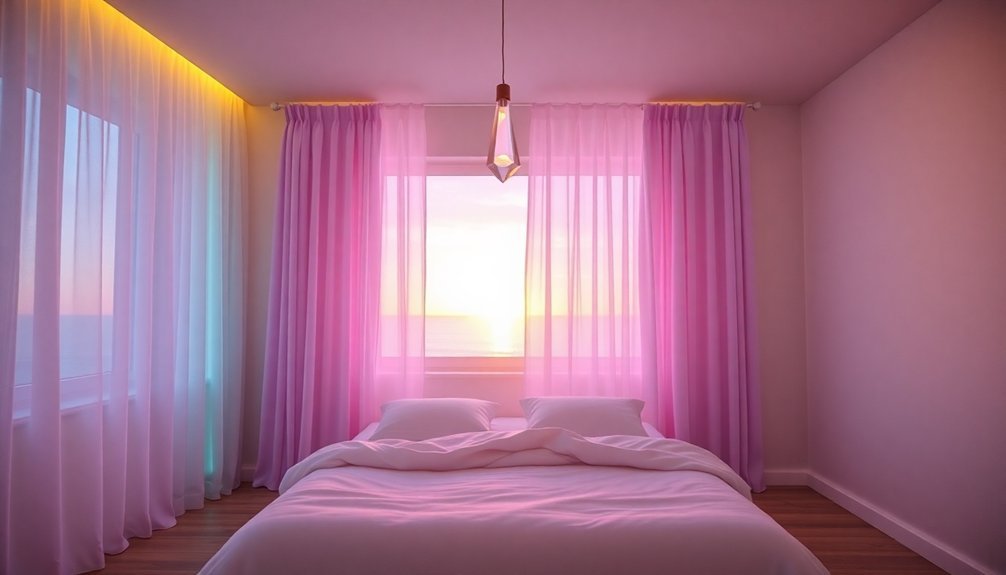
Creating a color therapy setup in your bedroom requires thoughtful consideration of both environmental elements and practical tools. Start by painting your walls in calming colors like soft green or dark blue, as these shades naturally promote relaxation and reduce stress levels.
You'll want to avoid stimulating colors like red and orange, which can interfere with your sleep patterns.
To maximize the benefits of color therapy, you'll need a basic kit that includes essential tools. Consider investing in color filters, a high CRI LED penlight, and a travel case for portability.
Don't forget to maintain consistent lighting throughout your space to help regulate your circadian rhythms.
- Use color visualization techniques before bed by imagining peaceful blue or green landscapes to enhance your relaxation response.
- Incorporate color-infused elements through bedding, curtains, or LED mood lighting that can be adjusted throughout the day.
- Practice color breathing exercises, where you visualize inhaling calming colors and exhaling stress.
You can also enhance your setup by downloading color therapy apps for guided exercises and ensuring you get adequate natural sunlight during the day for balanced color exposure.
Healing Properties of Blue Light
Beyond the calming effects of color therapy in your bedroom, blue light offers remarkable healing properties that extend far beyond sleep. While you'll want to avoid blue light exposure before bedtime due to its melatonin-suppressing effects, controlled blue light therapy during the day can provide significant therapeutic benefits for your skin and overall well-being.
You'll find that blue light effectively destroys acne-causing bacteria and reduces inflammation, making it particularly beneficial if you're dealing with breakouts or skin infections. It's also proven to stimulate collagen production, which helps diminish fine lines and wrinkles while improving your skin's texture and tone.
If you're concerned about healing wounds or scars, blue light therapy can accelerate tissue repair by increasing blood flow and cellular turnover.
What makes blue light therapy especially practical is its versatility. You can receive treatments at a dermatologist's office or use FDA-approved devices at home. Whether you're managing psoriasis, actinic keratosis, or seeking anti-aging benefits, blue light therapy offers a non-invasive solution.
Just remember to time your exposure appropriately, as evening blue light can disrupt your natural sleep patterns.
Green for Sleep Enhancement
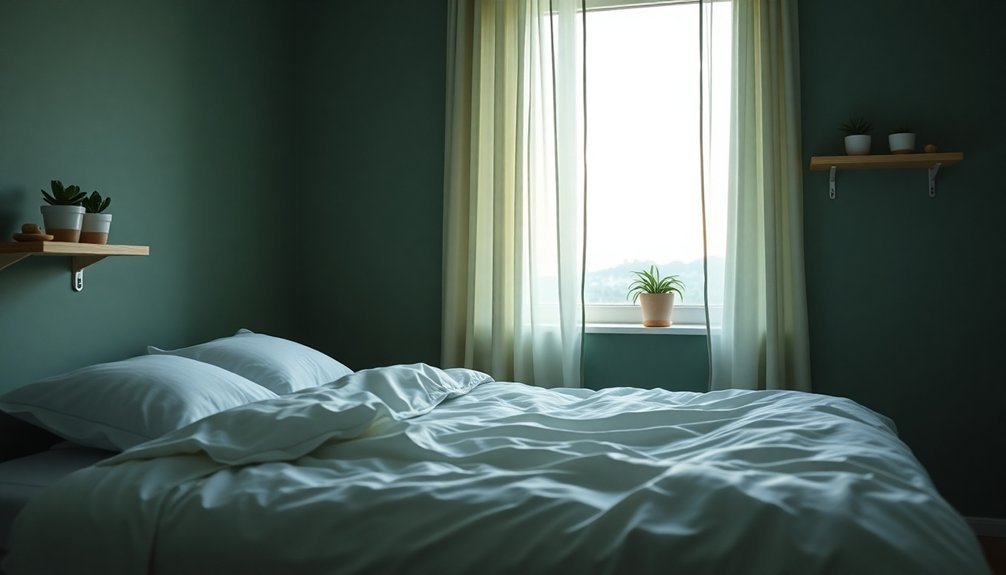
Discovering the power of green in your sleep environment might revolutionize your nightly rest. Research shows that green elements can markedly impact your sleep quality through multiple pathways, from visual cues to sound frequencies.
While studies on mice demonstrate rapid sleep onset with green light exposure, the effects on humans may differ but still hold promise for sleep enhancement.
You'll find green's influence on sleep extends beyond just lighting. The color itself promotes calmness and positive emotions, particularly when you choose muted or pastel shades for your bedroom. Additionally, green noise, which consists of mid-range frequencies similar to nature sounds, can effectively block out disturbances and lower stress hormone levels.
- Use green noise machines to create a natural, soothing soundscape that masks disruptive ambient noise
- Incorporate soft, muted green tones in your bedroom through paint, bedding, or decorative elements
- Consider replacing harsh blue lights with green alternatives in your evening environment
While more research is needed on green light's direct effects on human sleep, you can still benefit from green's calming properties through strategic bedroom design and sound therapy. The key is to create a sleep environment that mimics nature's restful elements.
Color Psychology in Rest
Your mind processes colors in ways that directly affect your sleep quality, with different hues triggering specific emotional and physiological responses that can either help or hinder your rest.
While stimulating colors like red and bright yellow can raise your heart rate and disrupt sleep, calming blues and soft earth tones can create the peaceful environment you need for better rest.
When you're choosing bedroom colors, it's important to take into account both the psychological impact and your personal emotional connections to different shades, as even the most scientifically supported sleep-friendly colors mightn't work if you have negative associations with them.
Mind's Response to Hues
Understanding how your brain responds to different colors can substantially impact your sleep quality. Your mind processes colors differently, with cool tones like blue and green promoting tranquility while warm hues like red and orange typically stimulate activity.
You'll find that soft blues can actually lower your heart rate and blood pressure, creating an ideal environment for rest.
When you're choosing bedroom colors, it's crucial to recognize that your personal and cultural background might influence how you react to specific hues. While most people respond well to calming blues and greens, your individual experiences might lead to different preferences.
The key is to identify which colors help your mind shift into a restful state.
- Blue light suppresses melatonin production, so you'll want to avoid bright white or blue lighting before bedtime
- Your brain responds best to low color temperature lighting (like warm reds and oranges) in the evening hours
- Personal color associations matter – if a particular color makes you feel peaceful, it's likely to support your sleep regardless of general color psychology principles
Emotional Color Connection
The emotional link between colors and sleep runs deeper than mere aesthetics. Your brain processes colors both instinctively and through learned associations, creating powerful emotional responses that can either enhance or disrupt your sleep quality.
These connections aren't random – they're rooted in both psychological studies and your natural relationship with environmental cues.
You'll find that cool colors like blue and green consistently promote relaxation and calmness, drawing from their associations with natural elements like peaceful waters and balanced forests. These colors can help lower your stress levels and prepare your mind for rest.
In contrast, you'll want to avoid warm colors like red and orange in your sleeping space, as they're known to energize and stimulate rather than calm.
Your cultural background and personal experiences also play a role in how you respond to different colors. While these individual variations exist, research shows that certain color responses are universal.
When you're designing your bedroom, consider that lighter shades typically evoke more positive emotions than darker ones, and neutral colors can provide a balanced foundation for your sleep environment.
Sleep-Friendly Color Selection
Selecting ideal bedroom colors requires a thoughtful balance between scientific research and personal comfort. While blue and green consistently rank as top choices for promoting restful sleep due to their ability to lower heart rate and blood pressure, you'll want to think about your individual response to different hues before making a final decision.
When choosing your bedroom colors, opt for matte finishes that minimize light reflection and create a cozy atmosphere. You'll find that soft pastels, neutral tones, and earthy shades like terracotta and sage green can help ground you before bedtime.
While bright, saturated colors like red and orange typically disrupt sleep patterns, softer versions of these hues can work if they personally resonate with you.
- Choose colors that align with your cultural background and personal experiences, as these factors markedly influence your emotional response to different shades.
- Think about incorporating layers of complementary neutral tones to create a versatile sleep environment that you can easily modify.
- Test paint samples during different times of day to verify your selected colors maintain their calming properties under varying light conditions.
Remember to avoid high-intensity shades and overly dark colors, as they can interfere with your natural sleep-wake cycle.
Earth Tones for Deep Sleep
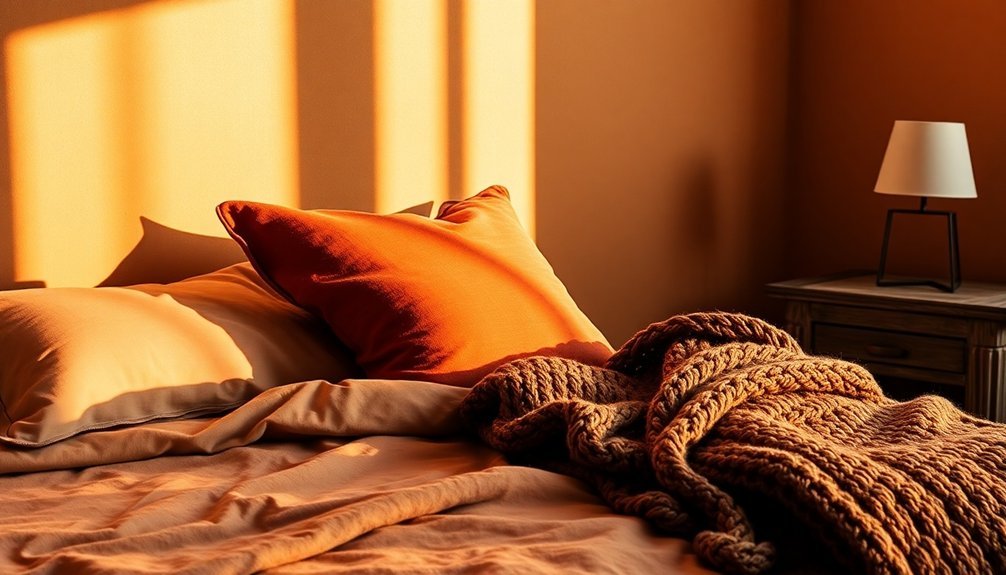
Nature's calming earth tones play a pivotal role in creating an ideal sleep environment. While red light therapy, particularly at 660 nanometers, has shown promising results for improving melatonin production and blood flow, you'll want to carefully consider how you incorporate this color into your bedroom design.
You'll find that lighter earth tones are typically more conducive to sleep than darker shades. Green, in particular, stands out as a highly recommended earth tone for bedrooms due to its calming properties.
When you're selecting colors, remember that personal preference matters substantially – what works for someone else mightn't work for you.
Research has demonstrated concrete benefits of red light therapy for sleep quality. In one study, female basketball players who received 30 minutes of red light therapy experienced improved melatonin levels.
However, you should note that while red light therapy can be beneficial, painting your walls red mightn't yield the same results. Instead, consider incorporating softer earth tones for wall colors and using red light therapy as a complementary treatment if you're struggling with sleep issues.
Color Meditation Before Bed
Beyond choosing wall colors and light therapy, engaging in color meditation before bedtime offers another powerful approach to improving sleep quality.
You'll find that incorporating color-focused practices like coloring mandalas or visualizing calming hues can substantially reduce stress and prepare your mind for restful sleep. Blue and green colors particularly help regulate your circadian rhythms while promoting harmony and healing in your pre-sleep routine.
When you practice color meditation, you're tapping into both instinctual and learned responses to different colors. The repetitive movements of coloring combined with focusing on intricate patterns can suspend your inner dialogue and remove negative thoughts that often prevent quality sleep.
You'll notice that even short periods of coloring before bed can improve your sleep quality while helping you avoid electronic devices.
- Focus on blues and greens in your coloring choices to naturally calm your nervous system and promote healing
- Choose complex mandala patterns to engage your mind deeply enough to quiet racing thoughts
- Establish a regular coloring practice to reduce body aches, sleeping problems, and fatigue over time
Frequently Asked Questions
Can Color Therapy Help With Chronic Insomnia and Sleep Disorders?
Yes, color therapy can help with your chronic insomnia. You'll find relief through specific colors like purple and blue, which affect your brain's sleep patterns and reduce stress levels through wavelength absorption.
How Long Does It Take to See Results From Bedroom Color Changes?
You'll notice immediate mood changes within 1-2 days of painting, but full sleep benefits take 2-3 weeks. For best results, give yourself time to adjust to your bedroom's new color scheme.
Do Color-Changing Smart Bulbs Provide the Same Benefits as Static Colors?
You'll get comparable benefits from smart bulbs and static colors, but smart bulbs offer added advantages like automated circadian rhythm adjustments, personalized scheduling, and dynamic color changes that enhance your sleep-wake cycle throughout the day.
Should Pillowcases and Bedding Match Wall Colors for Maximum Sleep Benefits?
Yes, you'll benefit from matching your pillowcases and bedding with wall colors. Choose calming tones like blues, greens, or warm neutrals to create a harmonious environment that'll enhance your sleep quality.
Can Combining Multiple Calming Colors Create Stronger Sleep-Inducing Effects?
Yes, you'll experience enhanced sleep benefits when you combine compatible calming colors. Try pairing soft purples with beige, or mixing muted reds with amber tones to create a more powerful sleep-inducing environment.
In Summary
You've now learned how colors can substantially impact your sleep quality and healing. Whether you choose calming blues, grounding earth tones, or invigorating greens, you'll find that thoughtful color choices in your bedroom make a difference. Remember to trust your personal responses to different hues, and don't hesitate to adjust your space until you find the perfect color combination that helps you drift into restorative sleep.

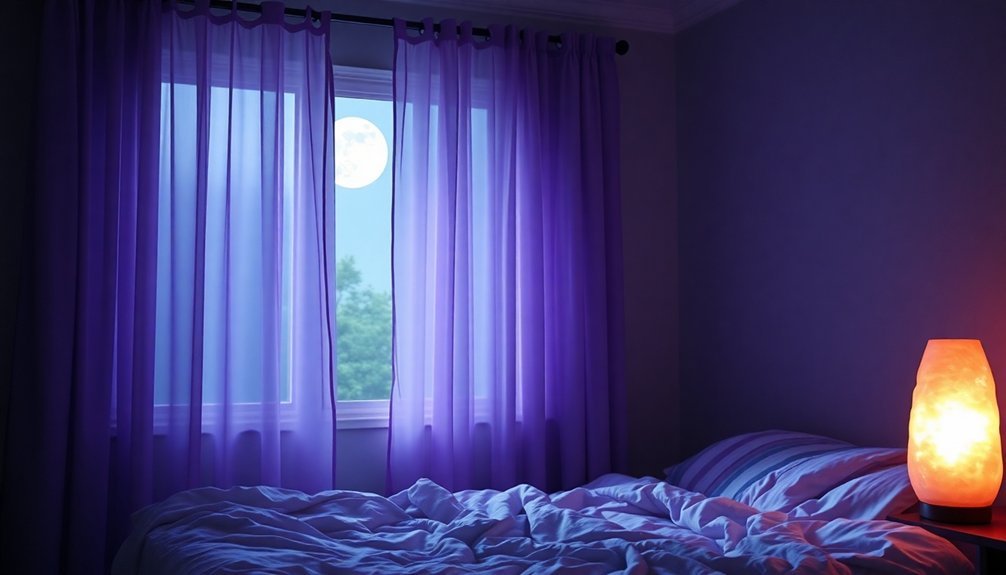



Leave a Reply